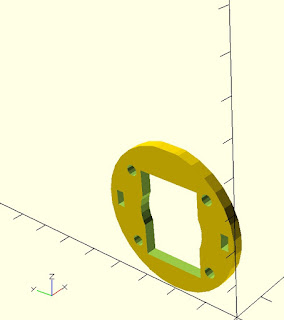My general idea for the design was to make some plywood centering rings to epoxy in a BT-70 tube, and make it so that I could have two all-thread rails to hold a sled, or else just cap off the end of the section after stuffing whatever I want in there.
A lot of this was made possible by the access to, and help with, the laser cutter at Boulder Public Library's BLDG61 - so lots of thanks to the super friendly and helpful folks there.
Parts
The parts, all cut and gathered together (not including hardware), are shown below.
The BT-70 tube is held in place by the two large rings to the right (from 1/8" plywood), with the smaller of the two going forward in the nose, and the aft ring being mounted flush in the shoulder.
The other pieces (in 3/32" ply), shown in this design view, are used to form the ends of the payload bay. Each end consists of two pieces. An "I" in the label means it fits inside the BT-70, and an "O" means it matches the outer diameter of the BT-70. Mated together, each set forms a nice, easy to center cap for an end of the tube.
- FI and FO are for the forward end.
- AI1 and AO1 are for an aft cap that can be bolted on without the use of rails.
- AI2 and AO2 are for an aft cap that is held on by two rails.
- The unlabeled rings are used to make an adapter so I can fit a BT-60 tube in the payload, since a recent version of my rocket tracker fits into a BT-60.
Additional hardware needed:
- 6-32 all-thread rod, approximately 20" depending on the exact bay length.
- Two 6-32 T-nuts.
- Two 6-32 threaded inserts.
- 6-32 nuts, bolts and washers (two each).
- Two eye bolts, with matching nuts and washers.
- Epoxy
- Wood glue
Assembly
First, I aligned and glued FI and FO together, then inserted (and epoxied in place) two 6-32 T-nuts. These will allow me to insert, and also remove, the all-thread rods. Note that the large part of the T-nut will be away from the BT-70.
On the forward centering ring, I added a couple small square pieces of plywood to help hold two 6-32 screw-in threaded inserts, which I also reinforced with epoxy. These will be used to bolt on aft cap A1. The two small open holes will be used for eyebolts.
Next I glued the fore and assembly onto the BT-70 tube.
Then the forward centering ring. Note that I included some holes incase I ever put an altimeter in there (though I'm not putting a matching hole in the nose cone at this time).
The two pieces of A2 were matched and glued together. This photo shows how they will be held on to the bay with the all-thread rods.
Next I bolted and epoxied the eye bolts onto the aft centering ring.
Now, I cut off the end of the end of the nose cone, leaving as much of the shoulder in place as possible. I then epoxied in the BT-70 assembly on just the forward end, while using the aft centering ring (unglued at this time) to keep it in position.
Finally, I epoxied in the aft centering ring securely, then trimmed off the excess BT-70 tube. The nose cone is all set to go. I can choose to close up the bay with either A1 (cap with no rails) or A2 (rails) - though I have not yet designed or made a sled for A2.
Overall, the modifications added 103g to the 186g nose cone (with the A1 cap). Kind of a lot, but let's face it - Torrent is already a heavy beast not exactly optimized for weight.
As of this writing, I've not yet flight tested it. I have some concerns about the smallish eyebolts holding, especially if the payload adds any significant weight. I will probably do one or two initial tests with dead weight in the payload, instead of expensive electronics.
4/23/17 update: I did the first flight test withe the modified node cone on 4/23 at Tripoli Colorado's 4/23 launch. Just in case, I substituted dead weight for electronics. Everything was handled perfectly, so the next opportunity I have I'm going to do a launch with a larger I motor and include my custom built GPS tracker in the payload.
























